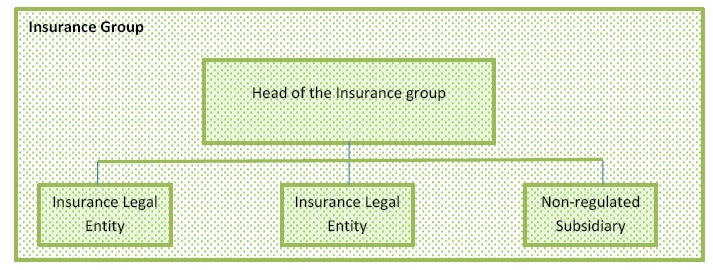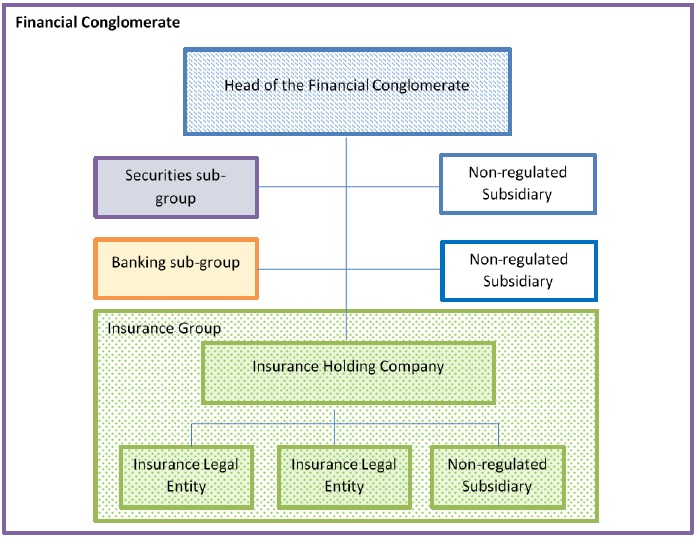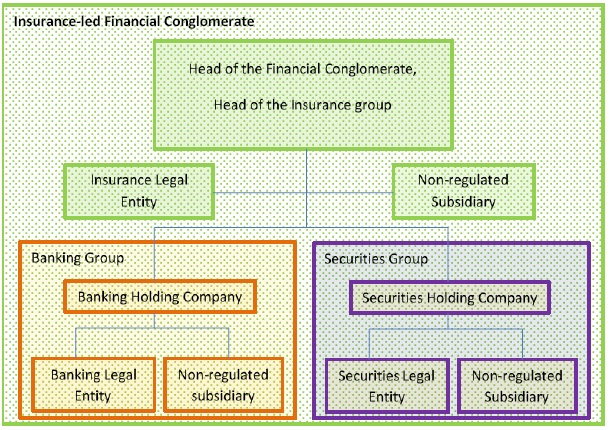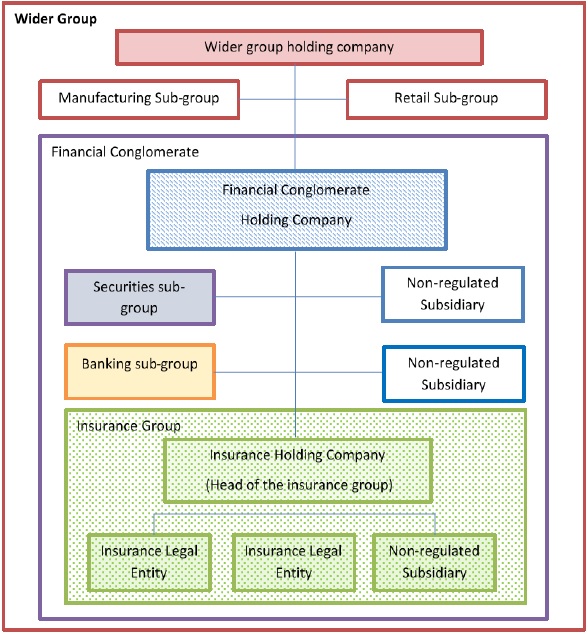The group-wide supervisor, in cooperation and coordination with other involved supervisors, identifies the insurance group and determines the scope of group supervision.
Involved supervisors should seek agreement amongst themselves on the identification of the insurance group, including the head of the insurance group, and the scope of group-wide supervision to ensure that gaps or duplication in regulatory oversight between jurisdictions do not occur. If agreement cannot be reached in a timely manner, the ultimate responsibility for determining the identification of the insurance group and scope of group-wide supervision rests with the group-wide supervisor. Decisions should be undertaken on a case-by-case basis and may include discussion with the insurance group.
The group-wide supervisor cooperates and coordinates with other involved supervisors, and should be accountable for the appropriateness of the identification of the insurance group and the determination of the scope of group supervision. In particular, in the case of insurance groups that operate on a cross-border basis, the group-wide supervisor should be able to explain the appropriateness of the identification of the insurance group and the determination of the scope of group supervision to involved supervisors in other jurisdictions. The identification of the insurance group and scope of group supervision should be reviewed regularly by the group-wide supervisor, in cooperation and coordination with other involved supervisors.
The group-wide supervisor should require the head of the insurance group to provide information needed on an ongoing basis to identify the insurance group and to determine the scope of group-wide supervision. The head of the insurance group provides the information to the group-wide supervisor, who disseminates it to the other involved supervisors as needed.
- Internationally active:
- Premiums are written in three or more jurisdictions; and
- Gross written premiums outside of the home jurisdiction are at least 10% of the group’s total gross written premiums.
- Size (based on a three-year rolling average):
- Total assets are at least USD 50 billion, or
- Total gross written premiums are at least USD 10 billion.
The criteria should be assessed based on the insurance group’s reported financial statements, either on a consolidated basis when available or as otherwise submitted to the group-wide supervisor. Intra-group transactions should be eliminated when calculating the amount of insurance business written in each jurisdiction and total insurance business written, and when calculating the total assets of the group.
“Total assets” are, at least, group assets related to the insurance business of the group.
“Gross written premiums” represent a measure of the volume of insurance business being written. Where alternative but similar volume measures are required under the accounting framework applicable to the group, then these alternative measures may be used as a more practical way of deciding if a group meets the criterion for an IAIG. An example of an alternative measure may be “premiums received” as required for disclosure purposes under International Financial Reporting Standard 17.
Although an insurance legal entity that has no parent or subsidiaries is not an insurance group, it should be regarded as an IAIG if it operates on a branch basis in foreign jurisdictions and meets the criteria. The supervisor of this entity, in cooperation with other involved supervisors, would determine whether the IAIG criteria are met. References to a ‘group’ in this context would include such entities operating through branches which are identified as IAIGs.
For the purposes of assessing groups against the internationally active criterion, the United States of America should be regarded as a single jurisdiction and member states of the European Union should be regarded as separate jurisdictions.
Any involved supervisor may prompt the process of identifying an IAIG. If no group-wide supervisor has been determined, the supervisor most demonstrating the characteristics of a group-wide supervisor should invite involved supervisors to participate in the process of determining whether a group is an IAIG.
The scope of an insurance group should be determined before considering whether the criteria for determining whether the group is an IAIG are met.
If there is already a supervisory college for a group, it should be used to facilitate the determination as to whether the group is an IAIG.
In limited circumstances the group-wide supervisor has discretion to determine that a group is not an IAIG even if it meets the criteria or that a group is an IAIG even if it does not meet the criteria.
If discretion has been used, then the reasons for exercising such discretion should be based on verifiable and documented quantitative and qualitative information.
- an other involved supervisor requests that the group be treated as an IAIG owing to the materiality of the operations in its jurisdiction;
- the group is expected to meet the criteria in the near future owing to mergers or acquisitions;
- the group’s international activity or size have decreased owing to some temporary or transitory effect such as an economic shock or exchange rate fluctuations and it would not be reasonable to alter the group’s identification as an IAIG for a short period;
- the group has related entities which are not included in the consolidated financial statements, but which are relevant to the risks of the group;
- the group has significant off-balance sheet assets (such as funds under management held on behalf of investors) which arise from insurance operations and so are more appropriately included in the total assets when assessing the group against the size criterion;
- the group changes or rearranges its business activities to avoid meeting the IAIG criteria including by splitting the insurance business into multiple sub-groups with separate operational controllers.
- the group will cease to meet the criteria in the near future owing to, for example, disposals of some or all of its insurance business;
- the group’s international activity or size have increased owing to some temporary or transitory effect such as an economic shock or exchange rate fluctuations and it would be unreasonable to identify the group as an IAIG for a short period; and
- the group’s business outside of the home jurisdiction exceeds 10% in aggregate but its business in any one jurisdiction outside the home jurisdiction is negligible.
The group-wide supervisor notifies the group of its decision to identify it as an IAIG and reasons for that decision.
The group-wide supervisor, in cooperation with other involved supervisors, regularly reviews previously made determinations concerning whether a group is an IAIG.
Such reviews should take place at least once every three years.
An ad hoc assessment should take place in circumstance where a significant change or event may impact the identification of a group as an IAIG.
The group-wide supervisor, in cooperation and coordination with other involved supervisors, identifies all legal entities that are part of the insurance group.
To ascertain the identity of an insurance group, supervisors should first identify all insurance legal entities within the corporate structure.
Supervisors should then identify all entities which have control over those insurance legal entities in the meaning provided for in the definition in ICP 6 (Changes in Control and Portfolio Transfers). If this results in only one identified entity, this entity is the head of the insurance group. If there is more than one entity with control over the insurance legal entities, supervisors should identify the head of the insurance group such as the entity which has the greatest level of control over the insurance business.
- an insurance legal entity; or
- a holding company.
- operating and non-operating holding companies (including intermediate holding companies);
- other regulated entities such as banks and/or securities companies;
- non-regulated entities; and
- special purpose entities.
- common Directors;
- membership rights in a mutual or similar entity;
- involvement in the policy-making process; and
- material transactions.
- a subset/part of a bank-led or securities-led financial conglomerate; or
- a subset of a wider group, such as a larger diversified conglomerate with both financial and non-financial entities.
Examples of the types of group structures that could be captured by the definition of insurance groups are provided in the diagrams below (Figure 23.1, 23.2, 23.3 and 23.4). These examples are for purposes of illustration only, and are not intended to set forth all possible forms of insurance groups.
The ICPs’ definition of “insurance group” may be different from the definitions used in other contexts, such as accounting or tax purposes.
The group-wide supervisor identifies the Head of the IAIG as the legal entity which controls all of the insurance legal entities within the group and non-insurance legal entities which pose risk to the insurance operations.
When identifying the Head of the IAIG, the group-wide supervisor considers both control as defined in ICP 6 (Changes in control and portfolio transfers) and operational control.
- select, appoint, or remove Board Members of related entities;
- determine remuneration of Board Members of related entities;
- set or influence capital expenditure and investment plans;
- set a dividend strategy and levels of surplus capital to be retained;
- determine new lines of business to be undertaken;
- set risk management policies and processes; and
- require reporting of management information.
- the proportion of the insurance business relative to other businesses it controls;
- the degree of operational control; and
- the degree of shareholder control.
Considering the above factors is particularly relevant when an IAIG has a vertical structure with several intermediate holding companies, is a financial or industrial conglomerate, or has several insurance sub-groups.
Consideration of which entity controls the greatest proportion of insurance business relative to other business may lead the group-wide supervisor to determine that the Head of the IAIG is an intermediate holding company rather than the ultimate parent of the group.
Consideration of where operational control is greatest may lead the group-wide supervisor to determine that the Head of the IAIG is an intermediate holding company rather than the ultimate parent of the group. It may also lead the group-wide supervisor to determine that one insurance legal entity is the Head of the IAIG by virtue of its operational control over another insurance legal entity even where it does not own that entity.
Consideration of where shareholder control is greatest may lead the group-wide supervisor to determine that the ultimate parent in a conglomerate is the Head of the IAIG rather than an intermediate holding company.
- a linkage between the insurance operations and the non-insurance legal entity (other than an investment in or from the non-insurance legal entities) that could adversely affect the insurance operations; and
- a lack of adequate safeguards, including additional capital, to mitigate risks arising from any such linkages.
Consideration of the control exerted over non-insurance legal entities within the group may lead the group-wide supervisor to determine that the Head of the IAIG is the ultimate parent of the group rather than an intermediate holding company.
A parent of the insurance legal entities is less likely to pose a risk to the insurance operations if the only linkage between it and the insurance legal entities is of the nature of a passive investment and so no operational control is being exerted.
The group-wide supervisor should be able to require preventive or corrective measures at the same level at which all the risks to insurance operations in the group (including funding risks) are mitigated by capital.
- prudential supervision is exercised by another financial sector supervisor over that entity; and
- the group-wide supervisor can rely on the other financial sector supervisor to provide sufficient information concerning risk that this entity and the legal entities it controls pose to the insurance operations.
The Head of an IAIG should not be a bank when:
- that bank is subject to prudential supervision exercised by another financial supervisor; and
- the group-wide supervisor is able to rely on this other financial sector supervisor to obtain information on the wider group and to ensure that the group is adequately capitalised.
If this precludes there being a single Head of the IAIG which controls all the insurance legal entities, then the group may be supervised as two or more separate IAIGs even if separately those IAIGs would not meet the size and international activity criteria.
The group-wide supervisor provides the supervisory college with the main reasons and judgements it made when identifying the Head of the IAIG.
As the supervisory college may qualify as a crisis management group for the IAIG (IAIG CMG), when identifying the Head of the IAIG, the group-wide supervisor should understand where resolution powers are applicable. The Head of the IAIG identified for prudential supervision purposes may not be the same as the entity at the level of which resolution powers will apply.
The group-wide supervisor, in cooperation and coordination with other involved supervisors, determines the scope of group-wide supervision.
Involved supervisors should consult and agree on the scope of group-wide supervision of the insurance group to ensure that there are no gaps and no unnecessary duplication in supervision among jurisdictions.
A practical method to determine the entities to capture within the scope of group-wide supervision is to start with entities included in the consolidated accounts. Entities that are not included in consolidated accounts should be included if they are relevant from the perspective of risk (non-consolidated entities also subject to supervision) or control. The entities that may be captured within the scope of group-wide supervision may either be incorporated or unincorporated.
In considering the risks to which the insurance group is exposed it is important to take account of those risks that emanate from the wider group within which the insurance group operates.
Individual entities within the insurance group may be excluded from the scope of group-wide supervision if the risks from those entities are negligible or group-wide supervision is impractical.
The exclusion or inclusion of entities within the scope of group-wide supervision should be regularly re-assessed.
It should be noted that the supervisory approach to entities/activities within the insurance group may vary depending on factors such as their types of business, legal status and/or nature, scale and complexity of risks. Although an insurance group as a whole should be subject to group-wide supervision, not all quantitative and qualitative supervisory requirements applied to an insurance legal entity should necessarily be applied to other entities within the group, to the insurance group as a whole, or to a sub-group collectively.
- the Head of the IAIG;
- with the cooperation of other involved supervisors, insurance legal entities controlled by the Head of the IAIG; and
- other non-insurance legal entities, whether or not controlled by the Head of the IAIG.
- any intermediate holding company or ultimate parent of the Head of the IAIG;
- any significant owner of the IAIG;
- any person exerting significant influence over the IAIG;
- any financial entity which is subject to supervision by an authority other than an insurance supervisor; or
- entities excluded from the consolidated data used to assess group solvency.
- the Head of the IAIG (insofar as the Head of the IAIG can legally procure that information);
- any supervisor of a related non-insurance financial entity; or
- the members of the Board, Senior Management and Key Persons in Control Functions involved in the insurance business, irrespective of the entity employing those persons.
The group-wide supervisor should understand how risks in non-regulated related group entities affect, for example, the risk management and capital adequacy of the IAIG. However this does not require the group-wide supervisor to supervise directly such entities.
The group-wide supervisor and other involved supervisors do not narrow the identification of the insurance group or the scope of group-wide supervision due to lack of legal authority or supervisory power over particular legal entities.
Where a supervisor has no direct legal power over certain legal entities in the scope of the group-wide supervision, the supervisor will use its power over regulated entities and/or consult with other involved supervisors to obtain similar supervisory outcomes.
In some jurisdictions, the supervisor may not be granted legal authority or supervisory power for the direct supervision of some entities within the identified insurance group or the scope of group-wide supervision. These may include legal entities regulated in another sector or non-regulated entities within the same jurisdiction.




